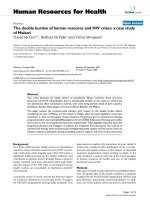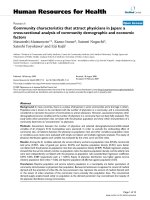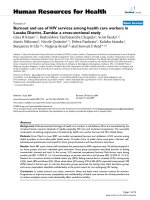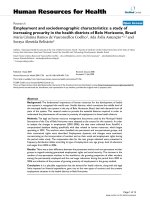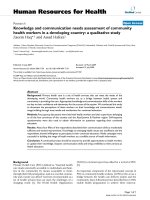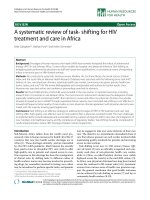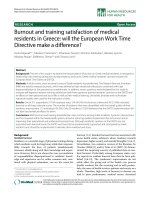Báo cáo sinh học: " Detection and frequency of recombination in tomato-infecting begomoviruses of South and Southeast Asia" pptx
Bạn đang xem bản rút gọn của tài liệu. Xem và tải ngay bản đầy đủ của tài liệu tại đây (346.89 KB, 10 trang )
BioMed Central
Page 1 of 10
(page number not for citation purposes)
Virology Journal
Open Access
Research
Detection and frequency of recombination in tomato-infecting
begomoviruses of South and Southeast Asia
HC Prasanna* and Mathura Rai
Address: Indian Institute of Vegetable Research, P B 5002, P 0-B H U, Varanasi, Uttar Pradesh, 221005, India
Email: HC Prasanna* - ; Mathura Rai -
* Corresponding author
Abstract
Background: Tomato-infecting begomoviruses are widely distributed across the world and cause
diseases of high economic impact on wide range of agriculturally important crops. Though
recombination plays a pivotal role in diversification and evolution of these viruses, it is currently
unknown whether there are differences in the number and quality of recombination events
amongst different tomato-infecting begomovirus species. To examine this we sought to
characterize the recombination events, estimate the frequency of recombination, and map
recombination hotspots in tomato-infecting begomoviruses of South and Southeast Asia.
Results: Different methods used for recombination breakpoint analysis provided strong evidence
for presence of recombination events in majority of the sequences analyzed. However, there was
a clear evidence for absence or low Recombination events in viruses reported from North India.
In addition, we provide evidence for non-random distribution of recombination events with the
highest frequency of recombination being mapped in the portion of the N-terminal portion of Rep.
Conclusion: The variable recombination observed in these viruses signified that all begomoviruses
are not equally prone to recombination. Distribution of recombination hotspots was found to be
reliant on the relatedness of the genomic region involved in the exchange. Overall the frequency
of phylogenetic violations and number of recombination events decreased with increasing parental
sequence diversity. These findings provide valuable new information for understanding the diversity
and evolution of tomato-infecting begomoviruses in Asia.
Background
Begomoviruses are an important group of whitefly (Bemi-
sia tabaci) transmitted viruses in the family Geminiviridae.
They inflict significant economic losses in many dicotyle-
donous crops including beans, cassava, cotton, melon,
pepper, potato and tomato [1-7]. Tomato yellow leaf curl
virus (TYLCV) and Tomato leaf curl virus (ToLCV) are the
begomoviruses severely constraining tomato production
in many tomato-growing regions of the world.
Begomovirus genomes are composed of either one (mon-
opartite) or two (bipartite) single stranded DNA mole-
cules ranging in size between 2500 and 2800 nucleotides
[8]. Most TYLCV of the old world and almost all known
new world begomoviruses viruses are bipartite with
genomes comprising DNA A and DNA B molecules. Mon-
opartite old world begomoviruses, which are now
believed to be the predominant begomovirus form, have
only a DNA-A like genome component. The virion-sense
strand of DNA A encodes the viral coat protein (AV1, V1
Published: 26 October 2007
Virology Journal 2007, 4:111 doi:10.1186/1743-422X-4-111
Received: 15 September 2007
Accepted: 26 October 2007
This article is available from: />© 2007 Prasanna and Rai; licensee BioMed Central Ltd.
This is an Open Access article distributed under the terms of the Creative Commons Attribution License ( />),
which permits unrestricted use, distribution, and reproduction in any medium, provided the original work is properly cited.
Virology Journal 2007, 4:111 />Page 2 of 10
(page number not for citation purposes)
or cp) and, in old-world begomoviruses [9], an AV2 or V2
gene that is necessary for virus accumulation and symp-
tom development [10]. The complementary-sense strand
of DNA-A encodes genes responsible for viral replication
(AC1, C1 or rep), replication enhancer (AC3, C3 or ren),
regulation of gene expression (AC2, C2 or trap) and AC4
or C4 involved in host range determination, symptom
determination, symptom severity, and virus movement
[11-13]. The DNA B of bipartite begomoviruses encodes
two proteins, BV1 (a nuclear shuttle protein or NS) and
BC1 (a movement protein or MP) involved in intra- and
inter-cellular movement within the plant [14].
Begomoviruses exhibit a great deal of geographic depend-
ent but host-independent genomic variation [15-17].
Recombination, especially interspecific homologous
recombination, is a key contributor to the genomic diver-
sification and evolution of begomoviruses [17]. To date,
many natural begomoviruses recombinants have been
reported [17-20]. Although the biological significance of
begomovirus recombination is not clearly understood, in
many parts of the world epidemics associated with the
emergence of recombinant begomoviruses have been
reported. These include the devastating cassava mosaic
disease epidemic caused by recombinant East African cas-
sava mosaic viruses in Uganda and neighbouring coun-
tries [18,21], the currently emerging pathogenic
recombinant, tomato yellow leaf curl Malaga virus, in
Spain [22] and the cotton leaf curl disease epidemic in
Pakistan caused by a species complex including a variety
of mostly recombinant begomovirus species [23]. Besides
the apparent importance of recombination in begomovi-
rus evolution the marks that it has left on currently sam-
pled begomovirus genome sequences also have major
implications when we attempt to use these sequences to
infer the evolutionary histories of begomoviruses [24,25].
Consequently, the detailed characterization of recombi-
nation amongst tomato-infecting begomoviruses is a pre-
requisite for understanding how these important
pathogens are evolving.
Although a few specific recombination events have been
described so far in tomato-infecting begomoviruses [26-
29], a full accounting of recombinants, recombination
breakpoints and recombination hotspots in tomato bego-
movirus species and strains is lacking. For example, it is
currently unknown whether there are differences in the
number and quality of recombination events that are
occurring amongst different tomato infecting begomovi-
rus species. It is also currently unknown whether
sequences in particular parts of the begomovirus genomes
are more or less exchangeable between different species
than sequences in other parts of these genomes. Such var-
iations in recombination frequencies and patterns have
been clearly observed in RNA viruses [30]. In this study we
employ a variety of recombination analysis methods to
characterize recombination in South and Southeast Asian
tomato-infecting begomoviruses. We map recombination
hotspots and provide evidence that not all tomato-infect-
ing begomoviruses are equally prone to recombination
and that specific characteristic of particular recombina-
tion events are reliant on both the relatedness of the
recombining viruses and the genomic region involved in
sequence exchanges
Results and discussion
In this study, we sought to characterise recombination in
South and Southeast Asian viruses using a different
approach to those used previously: (1) By studying a dif-
ferent set of viruses to those studied previously; (2) Mak-
ing use of a combination of recombination analysis
methods that are both powerful and have low false posi-
tive rates; (3) by mapping and estimating the frequency of
recombination events in begomoviruses.
The neighbor-net analysis revealed clear evidence of phy-
logenetic conflicts within the analysed sequences (Fig. 1).
Notably, every sequence represented within the tree was
implicated as a potential recipient of horizontally
acquired sequences at some time in its evolutionary past.
Unsurprisingly, the PHI test strongly supported the pres-
ence of recombination in these sequences (p < 0.0001).
Different methods used for recombination breakpoint
analysis also provided strong evidence for presence of past
recombination events in most of the sequences analysed.
For each of the 32 potential recombinant sequences iden-
tified, possible breakpoint positions, sequence fragments
and parental genotypes are listed in Table 1. Tomato leaf
curl virus from the Philippines and ToLCBV, ToLCBV-
[Ban4] and ToLCBV-[Ban5] from Bangalore, south India
appeared to be the most complex recombinants carrying
evidence of seven and six recombination events respec-
tively. On the opposite end of the spectrum, Tomato leaf
curl virus strains including ToLCNDV-Mld and ToLC-
NDV-[Luc] from New Delhi, ToLCNDV-Svr [Jes] from
Bangladesh, and TYLCCNV-Tb [Y38] from China each car-
ried evidence of only a single recombination event. In
addition, viruses from geographically well separated
regions appeared to have recombined at some time in the
past. For example, tomato leaf curl virus strains from Ban-
galore and Gujarat in India contained sequences closely
resembling those found in a ToLCTWV isolate from Tai-
wan. Also, Chinese viruses contained fragments of
sequence closely resembling those found in sequences
sampled in Thailand, Taiwan, Bangladesh and South
India. Further, we used the TreeOrderScan method [31] to
investigate the phylogenetic evidence for recombination
in the sequence alignment. This analysis revealed major
deviations in the branching order of sequences within
Virology Journal 2007, 4:111 />Page 3 of 10
(page number not for citation purposes)
trees constructed from different portions of the multiple
sequence alignment (Fig. 2). Frequent tree order changes
were observed at the region of rep and AC4. Importantly,
most of the viruses detected as recombinants in the break-
point analysis exhibited deviations in their branching
order indicating that they were most likely correctly iden-
tified as recombinants. In addition, the TreeOrderScan
analysis also provided evidence for gene flow amongst
viruses in geographically separated regions. For instance,
sequences found in southern Indian viruses grouped with
those found in Thailand and Bangladesh virus positions
from 2335–2652. Thai viruses contained sequences
resembling those of Chinese viruses between 300–490
and 590–2372, but Indian viruses between 2472–2743.
The recombination observed between geographically sep-
arated species/strains probably represents older events as
they presumably occurred before their present separation
[19]. Movement of vectors and/or infected plant materials
may also have contributed to the gene flow observed
between these widely separated locations [32]. Alterna-
tively, it is possible that current sampling of Asian bego-
movirus diversity is so sparse that we do not yet fully
appreciate the geographical range of many of the species
studied here.
Interestingly, our breakpoint analysis indicated that three
north Indian viruses (ToLCNDV-[PkT1/8], ToLCNDV-Svr
and ToLCNDV-[PkT5/6]) were not detectably recom-
binant and three other north Indian viruses namely ToL-
CNDV-Mld, ToLCNDV-[Luc] and ToLCNDV-[Luf] were
simple recombinants with only evidence of a single
detectable recombination event involving a virus resem-
bling ToLCPV sampled in the Philippines. While TreeOr-
derScan analysis also revealed an absence of
recombination in two north Indian viruses, ToLCNDV-
[PkT1/8] and ToLCNDV-[Luf] (indicated by a horizontal
line across the graph in Fig. 2). In addition, there was no
phylogenetic support for inter-group recombination event
reported for ToLCNDV-[Luc]. Thus there appears to be no
or few recombination events in viruses reported from
North India, signifying that certain begomovirus species
may not recombine as readily as others. There are a
Neighbor-Net generated for the tomato-infecting begomoviruses of South and Southeast AsiaFigure 1
Neighbor-Net generated for the tomato-infecting begomoviruses of South and Southeast Asia. Evidence for
reticulate evolution is reported on pairwise Hamming distances using only parsimonious sites. Networked relationships among
the viral species with boxes, instead of bifurcating evolutionary tree indicate to the presence of recombination.
Virology Journal 2007, 4:111 />Page 4 of 10
(page number not for citation purposes)
Table 1: Breakpoint analysis of tomato-infecting begomoviruses and their putative parental sequences.
Species/Strain ORF Breakpoint Possible parent Method*
ToLCNDV-Mld AC1 2119–2211 Unknown gc, rdp
ToLCNDV-Svr [Jes] AC1, AC4 1953–2507 ToLCPV-[LB] RDP, gc
ToLCNDV-[Luc] AC1, AC4 1960–2514 ToLCPV RDP, gc
ToLCBV-[Ban4] AV1, AV2 481–894 ToLCKV GC, rdp. mc
AC1, AC2, AC3 1185–1784 Unknown gc
AC1 1793–1894 Unknown rdp
AC1, AC4 2076–2632 ToLCGV-[Vad] RDP
ToLCGV-[Var] GC
ToLCGV-[Kel] MC
ToLCBV-[Ban5] AV1, AV2 481–894 ToLCKV GC, rdp
AC1, AC2, AC3 1185–1784 Unknown gc
AC1 1793–1894 Unknown rdp, mc
2579–2708 ToLCBDV GC, MC, rdp
AC1, AC4 2144–2734 ToLCTWV GC
2183–2376 ToLCTWV RDP
ToLCBV-[Kol] AV1, AV2 481–894 Unknown rdp
AC1, AC2, AC3 1185–1784 Unknown gc
AC1 1793–1894 Unknown rdp
AC1, AC4 2144–2727 ToLCTWV GC
2183–2376 ToLCTWV RDP
ToLCBV AV1, AV2 481–894 ToLCKV RDP, GC
AC1, AC2, AC3 1185–1784 Unknown gc
AC1 1793–1894 Unknown rdp
2585–2623 ToLCPV-[LB] RDP
AC1, AC4 2141–2724 ToLCTWV RDP
2180–2374 ToLCTWV GC
ToLCGV-[Kel] AV1, AV3 598–1214 TYLCTHV-[Y72] RDP, gc
TYLCTHV-[1] MC
AC1, AC2, AC3 1183–1782 Unknown gc
AC1, AC4 2160–2514 ToLCTWV RDP, GC
ToLCGV-[Var] AV1, AV3 603–1219 TYLCTHV-[Y72] RDP, gc
TYLCTHV-[1] MC
AC1, AC2, AC3 1188–1787 Unknown gc
AC1, AC4 2165–2519 ToLCTWV GC
ToLCGV-[Vad] AV1, AV3 598–1214 TYLCTHV-[1] RDP, MC, gc
AC1, AC2, AC3 1183–1782 Unknown gc, mc
AC1, AC4 2160–2514 ToLCTWV RDP, GC
TYLCCNV-Tb [Y36] AV1, AV2 451–924 ToLCPV-[LB] RDP, gc
AC1, AC4 2053–2213 ToLCTWV GC
TYLCCNV-Tb [Y38] AV1, AV2 451–924 ToLCPV-[LB] RDP, gc
TYLCCNV-[Y64] AV1 525–927 ToLCSLV RDP, gc
451–924 Unknown gc
AC1, AC4 2053–2213 ToLCTWV GC, RDP
TYLCCNV-Tb [Y8] AV1, AV2 451–924 ToLCPV-[LB] RDP, gc
AC1, AC4 2051–2210 ToLCTWV GC, RDP
TYLCCNV AV1, AV2 455–928 Unknown rdp, gc
AC1, AC4 2057–2217 ToLCBV-[Kol] GC, RDP
TYLCCNV-Tb [Y10] AV1, AV2 450–923 Unknown gc, rdp
AC1, AC4 2044–2482 TYLCTHV-[MM] RDP, GC
TYLCCNV-Tb [Y11] AV1, AV2 450–923 Unknown rdp. gc
AC1, AC4 2044–2482 ToLCTWV RDP
TYLCTHV-[MM] GC
TYLCTHV-[2] AV1, AV2 296–1197 Unknown rdp, gc
AC1, AC4 2200–2360 ToLCBDV GC
2390–2630 ToLCTWV RDP, GC
TYLCTHV-[1] AV1, AV2 305–1206 Unknown rdp, gc
AC1, AC4 2203–2363 ToLCBDV GC
2393–2633 ToLCTWV RDP, GC
TYLCTHV-[MM] AV1, AV2 157–1058 Unknown rdp, gc
Virology Journal 2007, 4:111 />Page 5 of 10
(page number not for citation purposes)
number of prerequisites for recombination between bego-
moviruses. These include shared host ranges (possibly
influenced by the emergence of B whitefly biotype), the
ability to co-infect the same cells [33-35], high levels of
viral replication [36], and overlapping geographical
ranges. If all of these prerequisites are met for the tomato-
infecting begomoviruses in South and Southeast Asia then
one would expect there to be frequent and invariable
recombination amongst all of these viruses. However, fit-
ness disadvantages may be associated with some sequence
exchanges that would lead to the selective elimination of
many newly produced recombinants.
The recombination sites distributed non-randomly along
the genome. The recombination breakpoints were
detected in all the six reading frames of south Indian
viruses and viruses from eastern and western India. The
breakpoints in the Chinese and Thai viruses were located
in AV1, AV2, AC1 and AC4, whereas ORFs AV1 and AV2
were identified to be cold spots in the Bangladeshi viruses.
The frequency and locations of recombination events
measured as topological differences between trees con-
structed from different parts of the alignment were visual-
ised as a half-diagonal compatibility matrix (Fig. 3). Each
X and Y coordinate in the matrix is a gross estimate of the
number of topological modifications needed to convert
the tree constructed using sequences at position X into
that constructed using sequences at position Y [31,37]. It
was apparent from this matrix that recombination events
are probably not randomly distributed throughout bego-
movirus genomes. The highest frequency of recombina-
tion apparently occurs in the portion of the C1/AC1 ORF
encoding the N-terminal portion of Rep. For example, the
matrix indicates that there are an excess of 0.16 phylogeny
violations per clade when trees constructed using
sequences between alignment positions 351 and 1251 are
2058–2218 ToLCBV-[Kol] GC
TYLCTHV-[Y72] AV1, AV2 158–1059 Unknown rdp, gc
AC1 2059–2219 ToLCBV GC
AC1, AC4 2249–2489 ToLCTWV RDP
TYLCCNV-Tb [Y10] GC
TYLCCNV-Tb [Y5] AV1 451–924 Unknown Gc
AC1 2051–2210 ToLCBV GC
TYLCCNV-Tb [Y25] AC1 2054–2214 ToLCTWV RDP, GC
2487–2661 Unknown Mc
ToLCKV AV1 708–875 ToLCBV-[Ban5] RDP, GC
AC1, AC2, AC3 1182–1781 Unknown gc, mc
AC1, AC4 2159–2513 ToLCTWV RDP, GC
ToLCJV-Mld AC1, AC2, AC3 1184–1783 Unknown gc, mc
AC1, AC4 2143–2736 TYLCCNV-Tb [Y5] RDP
TYLCCNV-Tb [Y25] GC
2058–2321 ToLCBV-[Kol] GC
2588–2642 TYLCCNV-Tb [Y5] GC
ToLCBDV AC1, AC2, AC3 1184–1783 Unknown gc, mc
AC1, AC4 2058–2321 ToLCTWV RDP
ToLCBV-[Kol] GC
2143–2735 Unknown rdp, gc
ToLCSLV AV1, AV2 132–467 ToLCBV-[Ban4] GC, MC
AC1, AC2, AC3 1097–1608 Unknown rdp, gc
AC1 1789–1890 Unknown rdp, mc
AC1, AC4 2140–2731 ToLCTWV RDP, gc, mc
ToLCMV IR 2687–34 TYLCCNV-Tb [Y25] RDP
2687–38 TYLCCNV RDP
2687–61 Unknown Mc
ToLCPV AC1, IR 2537–77 TYLCCNV RDP
AV2, IR 2727–78 Unknown Rdp
IR, AV2 39–68 Unknown gc, mc
0–70 Unknown Gc
IR 2715–43 ToLCPV-[LB] MC
AC1, AC4 2306–2627 TYLCCNV-Tb [Y11] GC, mc
AC1 2508–2715 Unknown rdp, gc, mc
ToLCPV-[LB] AC1, AC4 2162–2685 Unknown rdp, gc
ToLCTWV AC1 2494–2671 Unknown gc, mc
*The method in upper case is for the method identifying putative parent
Table 1: Breakpoint analysis of tomato-infecting begomoviruses and their putative parental sequences. (Continued)
Virology Journal 2007, 4:111 />Page 6 of 10
(page number not for citation purposes)
compared with those constructed using sequences
between alignment positions 2451 and 2951. This analy-
sis also indicated the probable absence in certain regions
of begomovirus genomes of recombination events that
had any substantial phylogenetic effect. For example, all
phylogenetic trees constructed using coat protein gene
sequences were all in good agreement with one another
indicating a relative absence of recombination break-
points within the CP gene.
We examined phylogeny violations and number of
recombination events in our data set from the perspective
of parental sequence relatedness. We noted that in general
phylogeny violations clustered around the genetic dis-
tance 0.30. The observed frequency of phylogeny viola-
tions were inversely correlated (r = -0.36 p < 0.05) to the
pairwise distances of the fragments involved in exchange
(Fig. 4A). In addition, the number of recombination
events was also inversely correlated (r = -0.35 p < 0.05) to
the diversity between the exchanged fragments (Fig. 4B),
we used only identified parental sequences to estimate the
genetic distance between horizontally transferred frag-
ments and the sequences that they replaced. Overall the
frequency of phylogenetic violations and number of
recombination events decreased with increasing parental
sequence diversity. In a study with artificial and natural
geminivirus recombinants Martin and co-workers [38]
demonstrated that the degree of similarity between a hor-
izontally inherited sequence and the sequence it replaces
is an important determining factor of recombinant fitness.
Rather than the non-random distribution of break points
observed here being due to higher recombination rates in
some genome regions than others [39], the distribution
seems to have been created by natural selection only
allowing the survival of recombinants with high fitness. In
the more diverse genome regions where recombination
events are not detected it is possible that these regions
would not function properly when transferred into for-
eign genetic backgrounds.
Conclusion
Finally, the variable recombination and diversity-depend-
ent distribution of recombination hotspots in tomato-
infecting begomoviruses is valuable new information that
has emerged from this study. Perhaps this is the first
report of variable recombination reported among tomato-
infecting begomoviruses found in the same region. Fur-
ther, recombinant forms, recombination hot spots and
frequency of recombination documented in this study
would provide new information for understanding the
diversity and evolution of tomato-infecting begomovi-
ruses in Asia. In addition to evolutionary considerations,
understanding the implications of recombination
observed in these viruses on efforts to develop resistant
tomatoes through conventional breeding and genetic
engineering are important and attempts should be
focused on these issues for developing effective disease
management strategies. Given that the N-terminal portion
Phylogenetic compatibility matrix of tomato-infecting bego-movirus sequences, exhibiting frequencies of phylogeny viola-tions for each pairwise comparison of sequence fragmentsFigure 3
Phylogenetic compatibility matrix of tomato-infecting bego-
movirus sequences, exhibiting frequencies of phylogeny viola-
tions for each pairwise comparison of sequence fragments.
For this analysis sequence fragments of 300 bases and 100
base intervals were used. Phylogeny violations above the
threshold bootstrap value of 70% are shown. Frequencies are
color coded to indicate number of phylogeny violations per
sequence. The genome map drawn to scale has been super-
imposed to indicate the positions of genes in DNA A
sequences. Positions were drawn relative to the ToLCGV-
[Var] strain.
0
300
600
900
12 0 0
15 0 0
18 0 0
2100
2400
2700
3000
0 300 600 900 1200 1500 1800 2100 2400 2700 3000
0
0.08
0.04
0.12
0.16
0.20
>0.2
A
C
4
A
C
1
A
V
2
A
C
2
A
C
3
A
V
1
I
R
TreeOrder Scan of tomato-infecting begomoviruses sequencesFigure 2
TreeOrder Scan of tomato-infecting begomoviruses
sequences. Changes in tree order(Y axis) resulting from
changes in phylogenetic relationships at 70% bootstrap level
are shown for sequential 300 bases sequence fragments at
100 base fragment intervals (X axis). Sequences are assigned
to groups based on geographical locations and groups are
color coded as indicated by labels. The genome map drawn
to scale has been superimposed to indicate the positions of
genes in DNA A sequences. Positions were drawn relative to
the ToLCGV-[Var] strain.
0
20
40
200 625 1025 1425 1825 2225 2625
Distance
North India South India East & West India China
Thailand Bangladesh Sri Lanka
Malaysia, Taiwan & Philippines
Tree order
AV2
IR
AV1
AC3
AC2
AC1
AC4
Virology Journal 2007, 4:111 />Page 7 of 10
(page number not for citation purposes)
of rep is highly recombinogenic it is perhaps worrying that
so many virus derived transgenic resistance strategies are
focusing on this portion of the geminivirus genome [40-
43]. It may be wiser to develop virus derived resistance
strategies using genome regions that are less recombino-
genic as this will make it more difficult for viruses to over-
come resistance by simply replacing targeted genome
regions with variants that are not targeted.
Methods
Sequence data
The study sequences comprised 35 publically available (as
on June 2006) complete Indian, Pakistani, Chinese, Bang-
ladeshi, Sri Lankan, Malaysian, Thai, Philippine and Tai-
wanese tomato-infecting begomovirus DNA-A and DNA-
A-like components (Table 2). These sequences were
aligned using the CLUSTAL W [44] using gap open and
extension penalties- of 10.
Phylogenetic network and pairwise homoplasy test
Phylogenetic evidence for recombination was detected
with Splits-Tree version 4.3 [45] using the neighbor-Net
method [46]. Neighbor-net depicts conflicting phyloge-
netic signals in the data that are caused by recombination
as cycles within unrooted bifurcating trees. Although, we
report evidence for reticulate evolution in such phyloge-
netic graphs obtained using parsimonious sites, pairwise
Hamming distances and no gaps, we obtained similar
results with other distance measures and settings.
We statistically verified the presence of recombination
identified visually in phylogenetic graphs using the pair-
wise homoplasy test (PHI) implemented in Splits Tree
4.3. PHI has been shown to powerfully identify the pres-
ence/absence of recombination within a wide range of
sequence samples with a low false positive rate [47].
Detection of recombination breakpoints
The recombination breakpoint analysis was carried out
using Recombination detection program RDP [48],
GENECONV [19] and MAXIMUM CHI SQUARE [49],
selected following the conclusions of studies on evalua-
tion of different methods of recombination detection
[50,51]. All these methods are implemented in RDP2
[52,53]. Default RDP2 settings were used throughout (P-
value cut-off = 0.05 and the standard Bonferroni correc-
tion was used), other than that sequences were considered
as circular, consensus daughters were found and break-
points were polished. We used principally the informa-
tion inferred by more than one method, as evaluation of
the performance of these recombination detection meth-
ods using simulated and empirical data indicated that one
should not rely too heavily on the results of a single
method (Posada, 2002). In RDP analysis, the length of the
window was set to 10 variable sites, and the step size was
set to one nucleotide. P values were estimated by rand-
omizing the alignment 1,000 times. For GENECONV
analysis, the g-scale parameter was set to 1 and the
number of permutations was set to 10,000.
Phylogenetic congruence
To examine phylogenetic support for each identified
recombination event in the breakpoint analysis, we used
the retained sequence position version of the TreeOrder
Scan method [31] implemented in Simmonics2005
(Version1.4) package. TreeOrder Scan records the posi-
tion of each sequence in a series of phylogenetic trees pro-
duced by sets of overlapping fragments across the
(A) Relationship between the number of phylogeny violations and fragment diversityFigure 4
(A) Relationship between the number of phylogeny violations and fragment diversity. Jukes-Cantor distance was calculated for
each pairwise comparison used in TreeOrder Scan analysis and corresponding violations were counted and plotted. (B) Rela-
tionship between the number of recombination events and fragment diversity. The fragments involved in the exchange with
identified parental sequences were used and the number of recombination events detected were counted and plotted.
0.00
0.04
0.08
0.12
0.16
0.20
0.0 0.1 0.2 0.3 0.4 0.5 0.6 0.7 0.8
Distance
Number of violations
A
B
1
3
5
7
9
11
13
0 0.14 0.2 0.26 0.32 0.38 0.44
Distance
Number of events
Virology Journal 2007, 4:111 />Page 8 of 10
(page number not for citation purposes)
genomes. Deviations in the tree order of individual
sequences and of group of sequences between fragments
of defined length indicate conflicting phylogenetic rela-
tionships. Alternatively, individual non-recombinant
sequences show constant tree order (position) across the
genome. In the present analysis, we recorded the changes
in the phylogenetic relationships of clades supported by
70 per cent bootstrap values for sequential 300 base
sequence fragments at 100 nucleotide intervals.
Frequency and mapping of recombination
Estimation of the frequency and mapping of the locations
of recombination events was achieved by phylogeny com-
patibility analysis using the TreeOrder Scan method. First,
the TreeOrder Scan program produces optimally ordered
neighbor-joining trees for fragments of definite length
along an alignment. In the next step, a pairwise compari-
son is made between trees constructed from each
sequence fragment along the alignment. Then a phyloge-
netic compatibility value is computed as the number of
times the phylogeny of one tree has to be violated to
match the tree order observed in other trees constructed
along the length of an alignment. In our case we assigned
sequences to predefined groups based on their geograph-
ical origin and a bootstrap value of 70 per cent was used
as threshold for scoring phylogeny violations. All pairwise
compatibility values were calculated using trees con-
structed for 300 nucleotide sequence fragments separated
by 100 nucleotides across the length of the analysed align-
ment. These compatibility values were then plotted on a
phylogenetic compatibility matrix.
Competing interests
The author(s) declare that they have no competing inter-
ests.
Table 2: List of species/strains of tomato-infecting begomoviruses used in the present study.
Species/strain Genbank accession Abbreviation
Tomato leaf curl Bangalore virus Z48182 ToLCBV
Tomato leaf curl Bangalore virus-[Ban4] AF165098
ToLCBV-[Ban4]
Tomato leaf curl Bangalore virus-[Ban5] AF295401
ToLCBV-[Ban5]
Tomato leaf curl Bangalore virus-[Kolar] AF428255
ToLCBV-[Kol]
Tomato leaf curl Bangladesh virus AF188481
ToLCBDV
Tomato leaf curl Gujarat virus-[Kelloo] AF449999
ToLCGV-[Kel]
Tomato leaf curl Gujarat virus-[Vadodara] AF413671
ToLCGV-[Vad]
Tomato leaf curl Gujarat virus-[Varanasi] AF190290
ToLCGV-[Var]
Tomato leaf curl Joydebpur virus-Mild AJ875159
ToLCJV – Mld
Tomato leaf curl Karnataka virus U38239
ToLCKV
Tomato leaf curl Malaysia virus AF327436
ToLCMV
Tomato leaf curl New Delhi virus-Mild U15016
ToLCNDV-Mld
Tomato leaf curl New Delhi virus-Severe U15015
ToLCNDV-Svr
Tomato leaf curl New Delhi virus-Severe [Jessore] AJ875157
ToLCNDV-Svr [Jes]
Tomato leaf curl New Delhi virus-[Lucknow] Y16421
ToLCNDV-[Luc]
Tomato leaf curl New Delhi virus-[Luffa] AF102276
ToLCNDV-[Luf]
Tomato leaf curl New Delhi virus-[PkT1/8] AF448059
ToLCNDV-[PkT1/8]
Tomato leaf curl New Delhi virus-[PkT5/6] AF448058
ToLCNDV-[PkT5/6]
Tomato leaf curl Philippines virus AB050597
ToLCPV
Tomato leaf curl Philippines virus-[LB] AF136222
ToLCPV-[LB]
Tomato leaf curl Sri Lanka virus AF274349
ToLCSLV
Tomato leaf curl Taiwan virus U88692
ToLCTWV
Tomato yellow leaf curl China virus AF311734
TYLCCNV
Tomato yellow leaf curl China virus-[Y64] AJ457823
TYLCCNV-[Y64]
Tomato yellow leaf curl China virus-Tb [Y10] AJ319675
TYLCCNV-Tb [Y10]
Tomato yellow leaf curl China virus-Tb [Y11] AJ319676
TYLCCNV-Tb [Y11]
Tomato yellow leaf curl China virus-Tb [Y36] AJ420316
TYLCCNV-Tb [Y36]
Tomato yellow leaf curl China virus-Tb [Y38] AJ420317
TYLCCNV-Tb [Y38]
Tomato yellow leaf curl China virus-Tb [Y5] AJ319674
TYLCCNV-Tb [Y5]
Tomato yellow leaf curl China virus-Tb [Y8] AJ319677
TYLCCNV-Tb [Y8]
Tomato yellow leaf curl China virus-Tb [Y25] AJ457985
TYLCCNV-Tb [Y25]
Tomato yellow leaf curl Thailand virus-[1] X63015
TYLCTHV-[1]
Tomato yellow leaf curl Thailand virus-[2] AF141922
TYLCTHV-[2]
Tomato yellow leaf curl Thailand virus-[Myanmar] AF206674
TYLCTHV-[MM]
Tomato yellow leaf curl Thailand virus-[Y72] AJ495812
TYLCTHV-[Y72]
Virology Journal 2007, 4:111 />Page 9 of 10
(page number not for citation purposes)
Authors' contributions
HCP conceived and designed the study; HCP, MR exe-
cuted the study and wrote the paper. Both the authors
read and approved the final manuscript.
Acknowledgements
We gratefully acknowledge Dr D P Martin for critical reading of the manu-
script, and very useful suggestions and comments. We thank Dr Peter Sim-
monds for inputs provided during the analysis, reading of the manuscript
and encouraging comments.
References
1. Brown JK, Bird J: Whitefly-transmitted geminiviruses and asso-
ciated disorders in the Americas and the Caribbean basin.
Plant Dis 1992, 76:220-225.
2. Moriones E, Navas-Castillo J: Tomato yellow leaf curl virus, an
emerging virus complex causing epidemics worldwide. Virus
Res 2000, 71:123-134.
3. Polston JE, Anderson PK: The emergence of whitefly-transmit-
ted geminiviruses in tomato in the western hemisphere.
Plant Dis 1997, 81:1358-1369.
4. Simone GW, Brown JK, Hiebert , Cullen RE: New geminivirus epi-
demics in Florida tomatoes and peppers. Phytopathology 1990,
80:1063.
5. Varma A, Malathi VG: Emerging geminivirus problems: A seri-
ous threat to crop production. Ann Appl Biol 2003, 142:145-164.
6. Morales FJ, Anderson PK: The emergence and dissemination of
white-fly transmitted geminiviruses in Latin America. Arch
Virol 2001, 146:415-441.
7. Briddon RW, Markham PG: Cotton leaf curl disease. Virus Res
2000, 71:151-159.
8. Harrison BD: Advances in geminivirus research. Annu Rev Phy-
topathol 1985, 23:55-82.
9. Harrison BD, Robinson DJ: Green shoots of geminivirology.
Physiol Mol Plant Pathol 2002, 60:215-218.
10. Padidam M, Beachy RN, Fauquet CM: The role of AV2 ("Pre-
coat") and coat protein in viral replication and movement in
tomato leaf curl geminivirus. Virology 1996, 224:390-404.
11. Jupin I, De Kouchkovsky F, Jouanneau F, Gronenborn B: Movement
of tomato yellow leaf curl geminivirus (TYLCV): Involve-
ment of the protein encoded by ORF C4. Virology 1994,
204:82-90.
12. Laufs J, Traut W, Heyraud F, Matzeit V, Rogers SG, Schell J, Gronen-
born B: In vitro cleavage and joining at the viral origin of rep-
lication by the replication initiator protein of tomato yellow
leaf curl virus. Proc Natl Acad Sci USA 1995, 92:3879-3883.
13. Wartig L, Kheyr-pour A, Noris E, De Kouchkovsky F, Jouanneau F,
Gronenborn B, Jupin I: Genetic analysis of monopartite tomato
yellow leaf curl geminivirus: roles of V1, V2, and C2 ORFs in
viral pathogenesis. Virology 1997, 228:132-140.
14. Noueiry AO, Lucas WJ, Gilbertson RL: Two proteins of a plant
DNA virus coordinate nuclear and plasmodesmal transport.
Cell 1994, 76:925-932.
15. Padidam M, Beachy RN, Fauquet CM: Classification and identifi-
cation of geminiviruses using sequence comparisons. J Gen
Virol 1995, 76:249-263.
16. Swanson MM, Brown JK, Poulos BT, Harrison BD: Genome affini-
ties and epitome profiles of whitefly-transmitted geminivi-
ruses from Americas. Ann Appl Biol 1992, 121:285-296.
17. Harrison BD, Robinson DJ: Natural genomic and antigenic var-
iation in whitefly-transmitted geminiviruses (begomovi-
ruses). Annu Rev Phytopathol 1999, 37:369-398.
18. Zhou X, Liu Y, Calvert L, Munoz C, Otim-Nape GW, Robinson DJ,
Harrison BD: Evidence that DNA-A of a geminivirus associ-
ated with severe cassava mosaic disease in Uganda has
arisen by interspecific recombination. J Gen Virol 1997,
78:2101-2111.
19. Padidam M, Sawyer S, Fauquet CM: Possible emergence of new
geminiviruses by frequent recombination. Virology 1999,
265:218-225.
20. Sanz AI, Fraile A, Gallego JM, Malpica JM, García-Arenal F: Genetic
variability of natural populations of cotton leaf curl geminivi-
rus, a single-stranded DNA virus. J Mol Evol 1999, 49:672-681.
21. Pita JS, Fondong VN, Sangare A, Otium-Nape GW, Ogwal S, Fauquet
CM: Recombination, pseudorecombination and synergism of
geminiviruses are determinants keys to the epidemic of
severe cassava mosaic disease in Uganda. J Gen Virol 2001,
82:655-665.
22. Monci F, Sanchez-Campos S, Navas-Castillo J, Moriones E: A natural
recombinant between the geminiviruses Tomato yellow leaf
curl Sardinia virus and Tomato yellow leaf curl virus exhibit
a novel pathogenic phenotype and is becoming prevalent in
Spanish populations. Virology 2002, 303:317-326.
23. Zhou X, Liu Y, Robinson DJ, Harrison BD: Four DNA A variants
among Pakistani isolates of cotton leaf curl virus and their
affinities to DNA A of geminivirus isolates from okra. J Gen
Virol 1998, 79:915-923.
24. Schierup MH, Hein J: Consequences of recombination on tradi-
tional phylogenetic analysis. Genetics 2000, 156:879-891.
25. Posada D, Crandall KA: The effect of recombination on accu-
racy of phylogeny estimation. J Mol Evol 2002, 54:396-402.
26. Delatte H, Martin DP, Naze F, Goldbach R, Reynaud B, Peterschmitt
M, Lett JM: South West indian ocean islands tomato begeo-
movirus populations represent a new major monopartite
begomovirus group. J Gen Virol 2005, 86:1533-1542.
27. Garcia-Andres S, Monci F, Navas-Castillo J, Moriones E: Begomovi-
rus genetic diversity in the native plant reservoir Solanum
nigrum: Evidence for the presence of a new virus species of
recombinant nature. Virology 2006, 350:433-42.
28. Andrade EC, Manhani GG, Alfenas PF, Calegario RF, Fontes EPB, Zer-
bini FM: Tomato yellow spot virus, a tomato-infecting bego-
movirus from Brazil with a closer relationship to viruses
from Sida sp., forms pseudorecombinants with begomovi-
ruses from tomato but not from Sida. J Gen Virol 2006,
87:3687-3696.
29. Garcia-Andres S, Tomas DM, Sanchez-Campos S, Navas-Castillo J,
Moriones E: Frequent occurrence of recombinants in mixed
infections of tomato yellow leaf curl disease-associated bego-
moviruses. Virology 2007, 365:210-219.
30. Worobey M, Holmes EC: Evolutionary aspects of recombina-
tion in RNA viruses. J Gen Virol 1999, 80:2535-2544.
31. Simmonds P, Midgley S: Recombination in the genesis and evo-
lution of Hepatitis B virus genotypes. J Virol 2005,
79:15467-15476.
32. Rojas MR, Hagen C, Lucas WJ, Gilbertson RL: Exploiting chinks in
plant's armor: Evolution and emergence of geminiviruses.
Annu Rev Phytopathol 2005, 43:361-394.
33. Sanchez-Compos SJ, Navas-Castillo R, Camero C, Soria JA, Diaz ,
Moriones E: Displacement of tomato yellow leaf curl virus
(TYLCV)-Sr by TYLCV-Is in tomato epidemics in Spain. Phy-
topathology 1999, 89:1038-1043.
34. Chowda Reddy RV, Muniyappa V, Colvin J, Seal SE: Diversity and
distribution of begomoviruses infecting tomato in India. Arch
Virol 2005, 150:845-867.
35. Ribeiro SG, Ambrozevicius B, Avil AC, Bezerra IC, Calegario RF,
Fernandes JH, Lima MF, de Mello RN, Rocha H, Zerbini FM: Distri-
bution and genetic diversity of tomato-infecting begomovi-
ruses in Brazil. Arch Virol 2003, 148:281-295.
36. Accotto GP, Mullineaux PM, Brown SC, Marie D: Digitaria streak
geminivirus replicative forms are abundant in S-phase nuclei
of infected cells. Virology 1993, 195:257-259.
37. Simmonds P, Welch J: Frequency and dynamics of recombina-
tion within different species of human enteroviruses. J Virol
2006, 80:483-493.
38. Martin DP, van der Walt E, Posada D, Rybicki EP: The evolutionary
value of recombination is constrained by genome modular-
ity. PLoS Genet 2005, 1:475-479.
39. Fauquet CM, Sawyer S, Idris AM, Brown JK: Sequence analysis and
classification of apparent recombination begomoviruses
infecting tomato in the Nile and Mediterranean basins. Phy-
topathology 2005, 95:549-555.
40. Noris E, Accotto GP, Tavazza R, Brunetti A, Crespi S, Tavazza M:
Resistance to tomato yellow leaf curl geminivirus in Nico-
tiana benthamiana plants transformed with a truncated viral
C1 gene. Virology 1996, 224:130-138.
41. Brunetti A, Tavazza M, Noris E, Tavazza R, Caciagli P, Ancora G,
Crespi S, Accotto GP: High expression of truncated viral Rep
protein confers resistance to tomato yellow leaf curl virus in
Publish with BioMed Central and every
scientist can read your work free of charge
"BioMed Central will be the most significant development for
disseminating the results of biomedical research in our lifetime."
Sir Paul Nurse, Cancer Research UK
Your research papers will be:
available free of charge to the entire biomedical community
peer reviewed and published immediately upon acceptance
cited in PubMed and archived on PubMed Central
yours — you keep the copyright
Submit your manuscript here:
/>BioMedcentral
Virology Journal 2007, 4:111 />Page 10 of 10
(page number not for citation purposes)
transgenic tomato plants. Mol Plant Microbe Interact 1997,
10:571-579.
42. Yang Y, Polston JE, Patte CP, Hiebert E, Sherwood TA: Use of
Tomato yellow leaf curl virus (TYLCV) Rep gene sequences
to engineer TYLCV resistance in tomato. Phytopathology 2004,
94:490-496.
43. Antignus Y, Vunsh R, Lachman O, Pearlsman M, Maslenin L, Hananya
U, Rosner A: Truncated Rep gene originated from Tomato
yellow leaf curl virus-Israel [Mild] confers strain-specific
resistance in transgenic tomato. Ann Appl Biol 2004, 144:39-44.
44. Thompson JD, Higgins DG, Gibson TJ: CLUSTAL W: improving
the sensitivity of progressive multiple sequence alignment
through sequence weighting, position-specific gap penalties
and weight matrix choice. Nucl Acids Res 1994, 22:4673-80.
45. Huson DH, Bryant D: Application of phylogenetic networks in
evolutionary studies. Mol Biol Evol 2006, 23:254-267.
46. Bryant D, Moulton V: Neighbor-Net: An agglomerative
method for the construction of phylogenetic networks. Mol
Biol Evol 2004, 21:255-265.
47. Bruen TC, Philippe H, Bryant D: A simple and robust statistical
test for detecting the presence of recombination. Genetics
2006, 172:2665-2681.
48. Martin D, Rybicki E: RDP: detection of recombination amongst
aligned sequences. Bioinformatics 2000, 16:562-563.
49. Maynard SJ: Analyzing the mosaic structure of genes. J Mol Evol
1992, 34:126-129.
50. Posada D, Crandall KA: Evaluation of methods for detecting
recombination from DNA sequences: computer simula-
tions. Proc Natl Acad Sci USA 2001, 98:13757-13762.
51. Posada D: Evaluation of methods for detecting recombination
from DNA sequences: Empirical data. Mol Biol Evol 2002,
19:708-717.
52. Martin DP, Williamson C, Posada D: RDP2: recombination detec-
tion and analysis from sequence alignments. Bioinformatics
2004, 21:260-262.
53. Recombination Detection Program (RDP) [http://Dar
win.uvigo.es/rdp/rdp.html]
